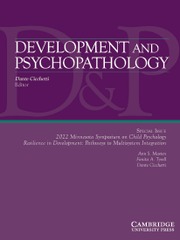Article contents
Earned security, daily stress, and parenting: A comparison of five alternative models
Published online by Cambridge University Press: 01 March 1998
Abstract
Research suggests that adults who have developed a coherent perspective on their negative,early attachment relationships (i.e., earned secures) do not reenact poor parenting practices withtheir own children. However, no studies have addressed whether earned secures maintainpositive parenting under the pressures of aversive environmental conditions. This study testedfive alternative models that predict how earned secures parent under low and high stress incomparison to adults who had a positive upbringing (i.e., continuous secures) and adults whohave an incoherent perspective on a troubled childhood (i.e., insecures). Only if earned securesexhibit effective caregiving under high stress, in comparison to the other security groups, can itbe assumed that they have broken the intergenerational cycle of poor parenting. The AdultAttachment Interview was used to classify 97 mothers as earned secure, continuous secure, andinsecure. Home observations of parenting and maternal self-reports of daily hassles (our stressmeasure) were obtained when children were 27 months old. Planned comparisons revealed thatthe diathesis-stress/incoherent present state of mind model most accurately predictedparenting. Thus, under high stress, the earned secures parented equivalently to the continuoussecures and more positively than the insecures; under low stress no group differences wereobtained. These findings indicate that in a normative sample earned secures break theintergenerational cycle and exhibit resilient parenting even under high stress conditions.
Information
- Type
- Research Article
- Information
- Copyright
- © 1998 Cambridge University Press
- 103
- Cited by

